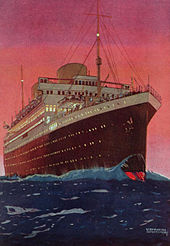Alcantara (ship, 1927)
|
||||||||||||||||||||
|
||||||||||||||||||||
|
||||||||||||||||||||
|
||||||||||||||||||||
|
||||||||||||||||||||
The RMS Alcantara (II) was a 1927 commissioned passenger ship of the British shipping company Royal Mail Line , which was used in passenger and mail traffic from Great Britain to South America . During the Second World War , the ship served as an auxiliary cruiser and later as a troop transport . In 1958 the Alcantara was broken up in Japan .
The ship
The 22,181 GRT motor ship Alcantara was built at Harland & Wolff in Belfast . She and her sister ship Asturias (II) (22,048 GRT) built at the same shipyard were the Royal Mail Line's largest ships to date. It was not until 1939 that a larger ship was built with the Andes (II) measuring 26,689 GRT . It was the name successor to the first Alcantara , which sank in 1916 after only two years in service in a battle with the German auxiliary cruiser Greif .
The 192.17 meter long and 23.92 meter wide passenger and mail ship had two funnels, two masts and two propellers and was powered by two diesel engines from Burmeister & Wain , which enabled a top speed of 16 knots. The ship was able to carry a total of 1306 passengers, of which 432 in the first, 200 in the second and 674 in the third class. The Alcantara and the Asturias were briefly the largest motor ships in the world. The Alcantara was launched on September 23, 1926 and was completed on February 18, 1927. On March 4, 1927, she ran from Southampton on her maiden voyage via Cherbourg , Lisbon and Las Palmas to Rio de Janeiro and Buenos Aires . She stayed on this route until the outbreak of war. In addition, it was occasionally used for cruises .
Since the diesel engines caused considerable vibrations at high speed, the two ships were temporarily withdrawn from service in 1934 for modernization measures. The hull of the Alcantara was lengthened to 202.99 meters and new Parsons steam turbines were installed, increasing the speed to 18 knots and solving the vibration problem. In addition, the chimneys were lengthened and the passenger accommodations were converted for 330 passengers in first, 220 in second and 768 in third class. As a result of the conversions, her tonnage increased slightly to 22,209 GRT. On May 4, 1935, the Alcantara was able to set sail again.
World War II and later years
In 1939 the Alcantara was converted into an armed auxiliary cruiser (Armed Merchant Cruiser). It was fitted with 150 mm cannons and the front chimney, which was only a dummy, was dismantled. The main mast was also removed. The Alcantara was sent to Malta for further reconstruction, but was involved in a violent collision with the Franconia of the Cunard Line on the way . She remained buoyant and reached Alexandria , where the hull was being repaired. In December 1939, she began her patrol service in the South Atlantic .
On July 28, 1940, there was a battle with the German auxiliary cruiser Thor in the South Atlantic . The Alcantara hit the Thor twice, but was hit by a total of three shells. One of the explosions flooded the engine room , so she had to reduce speed. The Thor withdrew into a haze of smoke and disappeared, and the Alcantara continued its journey to Rio to have makeshift repairs carried out. In 1943 she was converted into a troop transport and made troop trips to the Mediterranean , Singapore , Southeast Asia , Halifax , India and Ceylon .
On October 8, 1948, the Alcantara ran for its first post-war voyage in passenger traffic from Southampton to Buenos Aires. She had been converted to carry 220 passengers in first class, 185 in second class and 462 in tourist class. On April 17, 1957, she cast off for her last crossing. She had completed a total of 172 trips to South America. It was sold to Japan for demolition and made the crossing there under the name Kaisho Maru . It arrived in Osaka on September 30, 1958 , where it was scrapped shortly afterwards.
Afterlife
As part of the conversion to an auxiliary ship, the wooden mahogany paneling from the lobby was also removed. It was put into storage for reinstallation after the war. After the war, however, they were not reused and sold. The pastor of the Maltese congregation of Our Lady of Grace in Żabbar bought some panels. These were used as a platform for the altar at a festival of saints in 1951. Today they are in the local sanctuary museum as a space for small exhibitions.
Web links
- Summary ship data in The Ships List (approximately in the middle)

